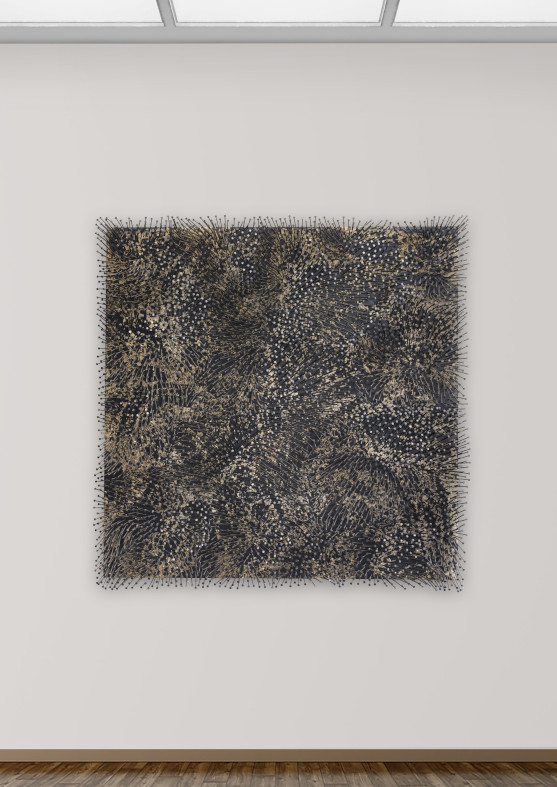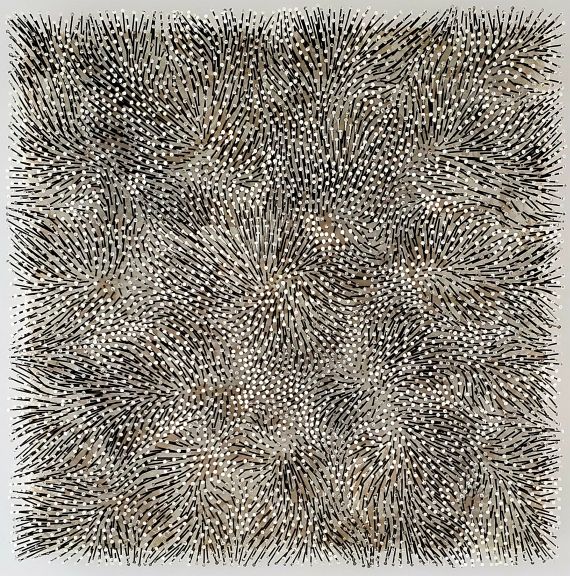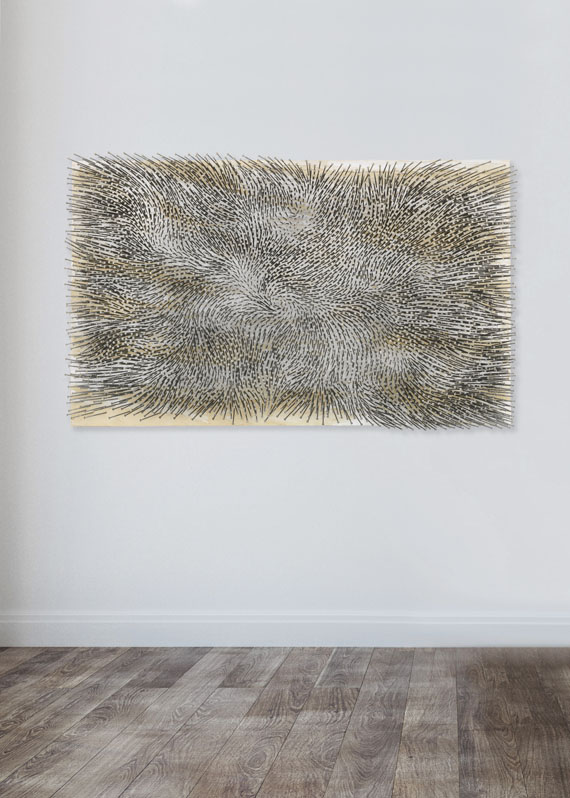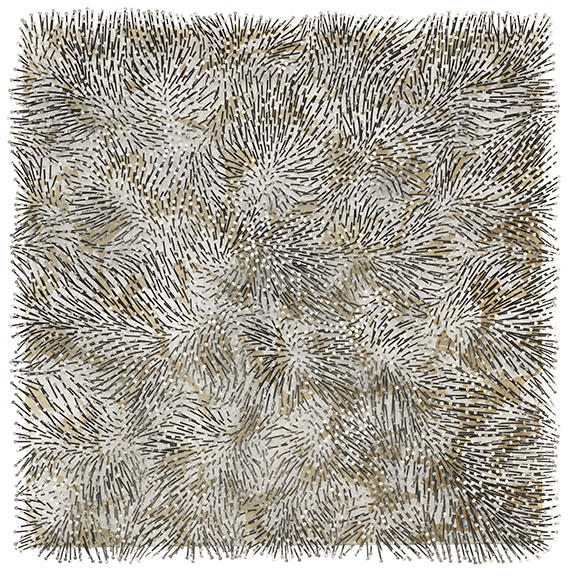5
Günther Uecker
Nacht, 1986.
Mixed media. Nails and black paint over canvas ...
Estimation: € 400,000 / $ 428,000
Nacht. 1986.
Mixed media. Nails and black paint over canvas and wood.
Signed, dated, titled and inscribed with a direction arrow on the reverse. 150 x 150 x 17 cm (59 x 59 x 6.6 in). [JS].
• “Nacht” - One of the extremely rare, large-scale energy fields in black.
• Mystical energy field with highly dynamic nailing: cosmic dissolution of boundaries in the expanse of “Nacht" accentuated by the powerful movement of the wind.
• Fascination of opposites: gentle movement and material hardness, vastness and finiteness, beauty and transience.
• “Where words end, the picture begins" (Uecker): The nail as an anonymous, industrial product becomes a carrier of intense spiritual expression.
• Of museum quality: in 2015 part of the legendary exhibition “Uecker” at K20, Düsseldorf, to mark the artist's 85th birthday.- “Nacht” - One of the extremely rare, large-scale energy fields in black.
• Mystical energy field with highly dynamic nailing: cosmic dissolution of boundaries in the expanse of “Nacht" accentuated by the powerful movement of the wind.
• Fascination of opposites: gentle movement and material hardness, vastness and finiteness, beauty and transience.
• “Where words end, the picture begins" (Uecker): The nail as an anonymous, industrial product becomes a carrier of intense spiritual expression.
• Of museum quality: in 2015 part of the legendary exhibition “Uecker” at K20, Düsseldorf, to mark the artist's 85th birthday.- “Nacht” - One of the extremely rare, large-scale energy fields in black.
• Mystical energy field with highly dynamic nailing: cosmic dissolution of boundaries in the expanse of “Nacht" accentuated by the powerful movement of the wind.
• Fascination of opposites: gentle movement and material hardness, vastness and finiteness, beauty and transience.
• “Where words end, the picture begins" (Uecker): The nail as an anonymous, industrial product becomes a carrier of intense spiritual expression.
• Of museum quality: in 2015 part of the legendary exhibition “Uecker” at K20, Düsseldorf, to mark the artist's 85th birthday.
This work is registered in the Uecker Archive under the number GU.86.047 and has been marked for inclusion in the forthcoming Uecker catalogue raisonné.
PROVENANCE: R. J. Vandevelde Collection (with the collector's stamp on the reverse).
Private collection Southern Germany (since 2006: Lempertz, Cologne, November 30, 2006, lot 941).
EXHIBITION: Uecker. Kunstsammlungen Nordrhein-Westfalen, K20 Grabbeplatz, February 7 - May 10, 2015.
LITERATURE: Lempertz, Cologne, auction 897, Zeitgenössische Kunst, November 30, 2006, p. 342, lot 941 (illu.).
Dieter Honisch, in: Günther Uecker. Zwanzig Kapitel, 2005, p. 60.
Called up: June 7, 2024 - ca. 17.08 h +/- 20 min.
Mixed media. Nails and black paint over canvas and wood.
Signed, dated, titled and inscribed with a direction arrow on the reverse. 150 x 150 x 17 cm (59 x 59 x 6.6 in). [JS].
• “Nacht” - One of the extremely rare, large-scale energy fields in black.
• Mystical energy field with highly dynamic nailing: cosmic dissolution of boundaries in the expanse of “Nacht" accentuated by the powerful movement of the wind.
• Fascination of opposites: gentle movement and material hardness, vastness and finiteness, beauty and transience.
• “Where words end, the picture begins" (Uecker): The nail as an anonymous, industrial product becomes a carrier of intense spiritual expression.
• Of museum quality: in 2015 part of the legendary exhibition “Uecker” at K20, Düsseldorf, to mark the artist's 85th birthday.- “Nacht” - One of the extremely rare, large-scale energy fields in black.
• Mystical energy field with highly dynamic nailing: cosmic dissolution of boundaries in the expanse of “Nacht" accentuated by the powerful movement of the wind.
• Fascination of opposites: gentle movement and material hardness, vastness and finiteness, beauty and transience.
• “Where words end, the picture begins" (Uecker): The nail as an anonymous, industrial product becomes a carrier of intense spiritual expression.
• Of museum quality: in 2015 part of the legendary exhibition “Uecker” at K20, Düsseldorf, to mark the artist's 85th birthday.- “Nacht” - One of the extremely rare, large-scale energy fields in black.
• Mystical energy field with highly dynamic nailing: cosmic dissolution of boundaries in the expanse of “Nacht" accentuated by the powerful movement of the wind.
• Fascination of opposites: gentle movement and material hardness, vastness and finiteness, beauty and transience.
• “Where words end, the picture begins" (Uecker): The nail as an anonymous, industrial product becomes a carrier of intense spiritual expression.
• Of museum quality: in 2015 part of the legendary exhibition “Uecker” at K20, Düsseldorf, to mark the artist's 85th birthday.
This work is registered in the Uecker Archive under the number GU.86.047 and has been marked for inclusion in the forthcoming Uecker catalogue raisonné.
PROVENANCE: R. J. Vandevelde Collection (with the collector's stamp on the reverse).
Private collection Southern Germany (since 2006: Lempertz, Cologne, November 30, 2006, lot 941).
EXHIBITION: Uecker. Kunstsammlungen Nordrhein-Westfalen, K20 Grabbeplatz, February 7 - May 10, 2015.
LITERATURE: Lempertz, Cologne, auction 897, Zeitgenössische Kunst, November 30, 2006, p. 342, lot 941 (illu.).
Dieter Honisch, in: Günther Uecker. Zwanzig Kapitel, 2005, p. 60.
Called up: June 7, 2024 - ca. 17.08 h +/- 20 min.
Our large energy field "Nacht" from 1986 is part of Uecker's most famous and highly sought-after group of works, the "Felder" (Fields), which emerged from Uecker's earlier, strictly linear "Raster" (Grids) and "Strukturen" (Structures). The "Felder" became the internationally acclaimed "ZERO" artist's key complex in which he made ever-new variations with great passion. In the spirit of the "ZERO" movement, Uecker reinvented art with his nail paintings, liberating it from the previously dominant significance of the painterly style as an artistic signature. Since the 1960s, Uecker, who declared the nail to be his distinctive means of artistic expression and lent it a spiritual and poetic dimension for the first time, has repeatedly explored the subject of his invention, the field of nails, spreading a dense structure of nails across the canvas in a swirling movement, initially in smaller and then increasingly larger formats. Since the 1980s, Uecker has used larger nails with long necks, which he placed on the canvas with even more force and which increasingly structured the pictorial space in more expansive movements, expanding the painterly accentuated surface into the third dimension. He also left the billowing necks of the nails partially unpainted, thus incorporating a stronger contrast of color and material into compositions intensified and animated by the effect of light and shadow. In Uecker's works of the 1980s, the force and dynamism behind their creation were more apparent than in the reduced compositions of the 1960s. While the individual nail in the strict choreography of earlier works had to fit in, it became increasingly emancipated, entering into clear counter-movements and tense confrontations. Uecker's unique artistic creations evoke memories of landscape impressions. His nail fields are reminiscent of grain fields or dune landscapes in a storm, and thus become documents of his childhood impressions of nature on the Baltic peninsula Wustrow. The idea of human humility before a sublime nature is a central aspect of Uecker's work. Accordingly, Uecker's fascinating creation "Nacht" is inevitably reminiscent of Caspar David Friedrich's famous painting "The Monk by the Sea" (1808/1810, Alte Nationalgalerie, Berlin), in which the inconspicuous figure of the monk depicted from behind becomes virtually one with the overwhelming impression of the nature around him, the vast sky and sea and the eternal cycle of growth and decay. This romantic view, which seeks the dissolution of man's boundaries in nature, shows clear parallels to Uecker's work, even if the artistic realization of these complex worlds of thought and feeling is completely different. In Uecker's work, the anonymous, industrial product of the nail becomes a carrier of intense spiritual expression, an artistic paradox that is still responsible for the unique aura of Uecker's powerful creations. The energy field "Nacht" is an outstanding example of the special power and density of associations emanating from Uecker's enormous oeuvre, oscillating between boundless vastness and finiteness, beauty and transience, life and death.
Today, Uecker's nail paintings can be found in important international collections like Tate Modern, London, the Guggenheim Museum, New York, the Neue Nationalgalerie and the Hamburger Bahnhof, Museum für Gegenwartskunst, Berlin, as well as the Centre Pompidou, Paris. [JS]
Today, Uecker's nail paintings can be found in important international collections like Tate Modern, London, the Guggenheim Museum, New York, the Neue Nationalgalerie and the Hamburger Bahnhof, Museum für Gegenwartskunst, Berlin, as well as the Centre Pompidou, Paris. [JS]
5
Günther Uecker
Nacht, 1986.
Mixed media. Nails and black paint over canvas ...
Estimation: € 400,000 / $ 428,000
Commission, taxes et droit de suite
Cet objet est offert avec imposition régulière ou avec imposition différentielle.
Calcul en cas d'imposition différentielle:
Prix d’adjudication jusqu’à 800 000 euros : frais de vente 32 %.
Des frais de vente de 27% sont facturés sur la partie du prix d’adjudication dépassant 800 000 euros. Ils sont additionnés aux frais de vente dus pour la partie du prix d’adjudication allant jusqu’à 800 000 euros.
Des frais de vente de 22% sont facturés sur la partie du prix d’adjudication dépassant 4 000 000 euros. Ils sont additionnés aux frais de vente dus pour la partie du prix d’adjudication allant jusqu’à 4 000 000 euros.
Le prix de vente inclut la taxe sur la valeur ajoutée, actuellement de 19%.
Calcul en cas d'imposition régulière:
Prix d'adjudication jusqu'à 800 000 € : 27 % de commission majorée de la TVA légale
Prix d'adjudication supérieur à 800 000 € : montants partiels jusqu'à 800 000 € 27 % de commission, montants partiels supérieurs à 800 000 € : 21 % de commission, à chaque fois majorés de la TVA légale.
Prix d'adjudication supérieur à 4.000 000 € : montants partiels supérieurs à 4.000 000 € : 15 % de commission, à chaque fois majorés de la TVA légale.
Si vous souhaitez appliquer l'imposition régulière, merci de bien vouloir le communiquer par écrit avant la facturation.
Calcul en cas de droit de suite:
Pour les œuvres originales d’arts plastiques et de photographie d’artistes vivants ou d’artistes décédés il y a moins de 70 ans, soumises au droit de suite, une rémunération au titre du droit de suite à hauteur des pourcentages indiqués au § 26, al. 2 de la loi allemande sur les droits d’auteur (UrhG) est facturée en sus pour compenser la rémunération liée au droit de suite due par le commissaire-priseur conformément au § 26 UrhG. À ce jour, elle est calculée comme suit :
4 pour cent pour la part du produit de la vente à partir de 400,00 euros et jusqu’à 50 000 euros,
3 pour cent supplémentaires pour la part du produit de la vente entre 50 000,01 et 200 000 euros,
1 pour cent supplémentaire pour la part entre 200 000,01 et 350 000 euros,
0,5 pour cent supplémentaire pour la part entre 350 000,01 et 500 000 euros et
0,25 pour cent supplémentaire pour la part au-delà de 500 000 euros.
Le total de la rémunération au titre du droit de suite pour une revente s’élève au maximum à 12 500 euros.
Calcul en cas d'imposition différentielle:
Prix d’adjudication jusqu’à 800 000 euros : frais de vente 32 %.
Des frais de vente de 27% sont facturés sur la partie du prix d’adjudication dépassant 800 000 euros. Ils sont additionnés aux frais de vente dus pour la partie du prix d’adjudication allant jusqu’à 800 000 euros.
Des frais de vente de 22% sont facturés sur la partie du prix d’adjudication dépassant 4 000 000 euros. Ils sont additionnés aux frais de vente dus pour la partie du prix d’adjudication allant jusqu’à 4 000 000 euros.
Le prix de vente inclut la taxe sur la valeur ajoutée, actuellement de 19%.
Calcul en cas d'imposition régulière:
Prix d'adjudication jusqu'à 800 000 € : 27 % de commission majorée de la TVA légale
Prix d'adjudication supérieur à 800 000 € : montants partiels jusqu'à 800 000 € 27 % de commission, montants partiels supérieurs à 800 000 € : 21 % de commission, à chaque fois majorés de la TVA légale.
Prix d'adjudication supérieur à 4.000 000 € : montants partiels supérieurs à 4.000 000 € : 15 % de commission, à chaque fois majorés de la TVA légale.
Si vous souhaitez appliquer l'imposition régulière, merci de bien vouloir le communiquer par écrit avant la facturation.
Calcul en cas de droit de suite:
Pour les œuvres originales d’arts plastiques et de photographie d’artistes vivants ou d’artistes décédés il y a moins de 70 ans, soumises au droit de suite, une rémunération au titre du droit de suite à hauteur des pourcentages indiqués au § 26, al. 2 de la loi allemande sur les droits d’auteur (UrhG) est facturée en sus pour compenser la rémunération liée au droit de suite due par le commissaire-priseur conformément au § 26 UrhG. À ce jour, elle est calculée comme suit :
4 pour cent pour la part du produit de la vente à partir de 400,00 euros et jusqu’à 50 000 euros,
3 pour cent supplémentaires pour la part du produit de la vente entre 50 000,01 et 200 000 euros,
1 pour cent supplémentaire pour la part entre 200 000,01 et 350 000 euros,
0,5 pour cent supplémentaire pour la part entre 350 000,01 et 500 000 euros et
0,25 pour cent supplémentaire pour la part au-delà de 500 000 euros.
Le total de la rémunération au titre du droit de suite pour une revente s’élève au maximum à 12 500 euros.




 Lot 5
Lot 5 


